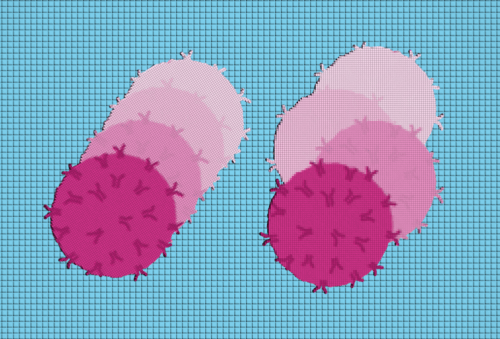Art by Alondra Moreno Santana
Think of your immune system as a personal bodyguard—one that not only defends you in the moment but also keeps a detailed record of past invaders. The next time the same pathogen strikes, your body reacts swiftly, neutralizing the threat before you even notice. But how does this remarkable memory work, and what determines how long it lasts?
B cells are critical to the immune system, producing antibodies that recognize and neutralize harmful microbes. “[Antibodies] are remarkable proteins that do two major things: they tag pathogens for destruction by the rest of the immune system; they also neutralize pathogens directly by binding to the parts of the virus that enable it to enter cells, blocking that process,” Michael Swift, a lead co-author of a recent Stanford study, said.
After an infection clears, some B cells become memory B cells, which remain on standby to rapidly respond to future encounters with the same pathogen. Others turn into long-lived plasma cells, continuously secreting antibodies for decades. “These cells provide the longest-lasting protection, offering a continuous supply of antibodies from infections you had decades ago,” Swift said. This dual system ensures both immediate recall and sustained protection.
While previous studies have mainly focused on B cells in the bloodstream, this study examined the bone marrow, spleen, and lymph nodes in the immune system at rest—not during an active response such as infection or vaccination. “One motivation for our study was understanding where long-lived B cells reside and how long-term memory is shared between the bone marrow and other tissues,” said Ivana Cvijović, the other lead co-author.
The researchers examined multiple human tissues, tracking how B cells mature and differentiate. Their findings revealed a surprising aspect of B cell behavior: while most B cells independently determine their fate, one subset of proliferating antibody-secreting cells, the ASC-3, shows coordinated behavior within lineages. This is an intriguing exception to the general pattern of independent decision-making. “When B cells respond to infection, they form lineages—families of related cells that differentiate into memory and plasma cells,” Swift explained. This supports the view that cell fate decisions are generally not coordinated within a lineage.
One of the study’s most unexpected discoveries was that the immune system continuously populates immune memory over time. “Our data revealed that B cells could migrate to the bone marrow—or any tissue—at any point during the process of refining antibodies. In other words, long-term antibody memory doesn’t just form at the end of the immune response; it develops continuously from the start,” Swift said. This finding challenges the previous assumption where plasma cells only arise after a “temporal switch” which occurs late in an immune response.
Another key finding was the widespread distribution of ASCs across various tissues. “Rather than centralizing antibody production, these cells seem to have the ability to disperse across all the tissues we sampled,” Swift said. Importantly, this applies to the ASC-3 subset of plasma cells, which are potentially not long-lived, showing that ASCs can be distributed more broadly.
Understanding how B cells develop long-term memory has major implications for vaccine design and immune-related diseases. “Once these cells are created, they can live for decades, providing protection against future threats,” Cvijović said. This may help explain why some vaccines provide lifelong immunity while others need regular updates.
The study also challenges previous assumptions about antibody memory formation. The process of antibody maturation and memory formation is more flexible and dynamic than previously thought, with immune cells not restricted to a specific timeline or location for establishing lasting immunity.
“Our study aims to provide a comprehensive multi-tissue, joint single-cell dataset that can serve as a foundational resource for the scientific community,” Swift said. The dataset could inspire further studies into the complex interactions between different tissues during immune responses and help refine our understanding of cell differentiation and memory formation.
While many questions remain—such as how B cells migrate and when key decisions occur—this research is an important step toward unraveling the mysteries of immune memory. As scientists continue to explore these mechanisms, their discoveries may pave the way for new approaches to investigating autoimmune diseases, vaccine development, and personalized treatments.

